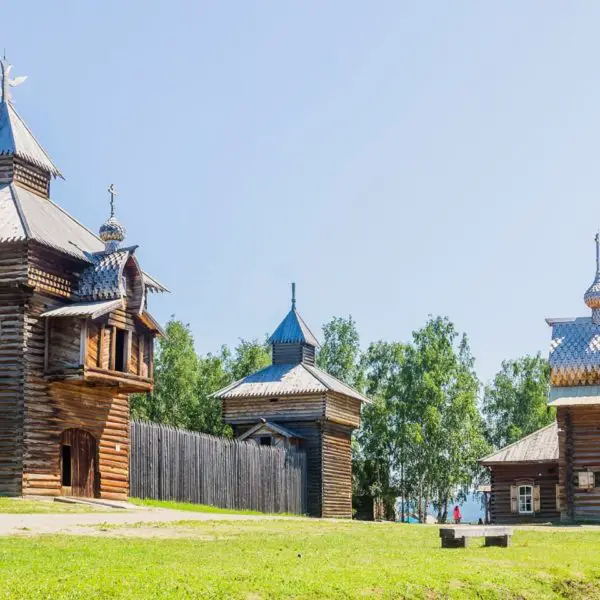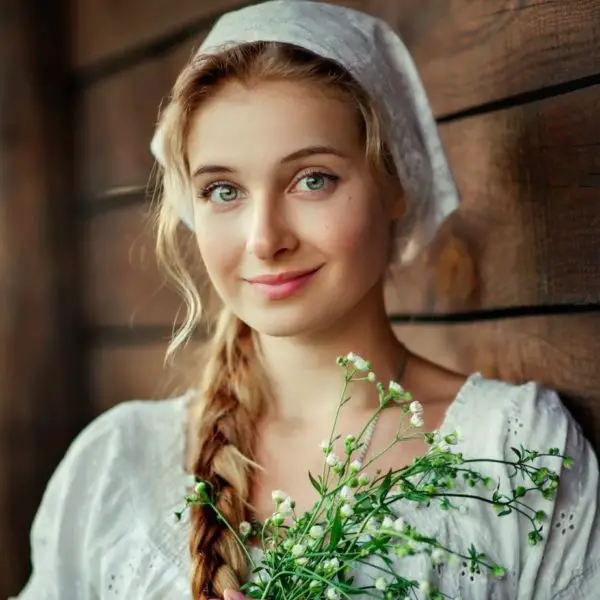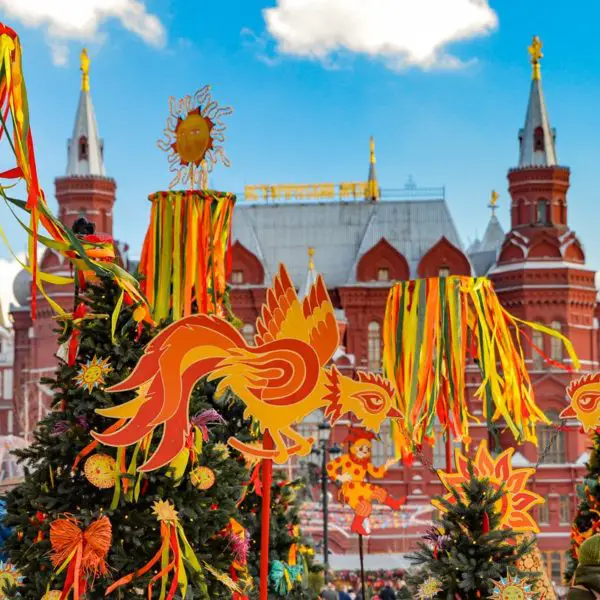Russian Food - 10 Dishes You Must Try
Russian food might not have the international renown of other, more widespread cuisines, but little-by-little, the foodie community is starting to uncover the true, delicious nature of traditional Russian food, and the unique, slightly eccentric and family-oriented philosophy that defines Russian food culture.
Forget those outdated, Soviet-era inspired ideas about Russian cuisine as stodgy and unimaginative. The truth is, Russia has a long and rich culinary history. Russian cooking is full of fascinating regional variations, and cities like Moscow and St Petersburg are undergoing a modern-day gourmet renaissance. With more and more fine-dining restaurants gaining global acclaim and a melange of international influences becoming infused in the Russian culinary landscape, Russia is attracting food-obsessed travellers who seek something out of the ordinary and come away surprised and totally satisfied.

It’s almost impossible to generalise what typifies traditional Russian cuisine. Being such a vast country full of different climates and dozens of diverse cultures, food in Russia can vary greatly from one region to the next. Yet there are certain dishes considered typical throughout much of the country (although the recipes may change from region to region), as you’ll discover below in our journey through the traditional flavours of Russia.
So, if you find yourself in Russia, keen to get a taste of authentic local fare, here’s some inspiration on what to eat and where to find it. Keep note of these famous Russian food names and be sure to put them on your Russia travel wish list!
Table of Contents
Blini
The ‘Russian pancakes’ known as blini (блины) are made with yeasted dough, giving them a light, fluffy texture and a distinctive tang. Blini can be stuffed with an endless variety of fillings, including a mixture of ground meat and diced vegetables or berries and cream cheese, although they’re often served simply, topped with sour cream, condensed milk or jam. Blini is also a traditional Russian accompaniment for caviar.
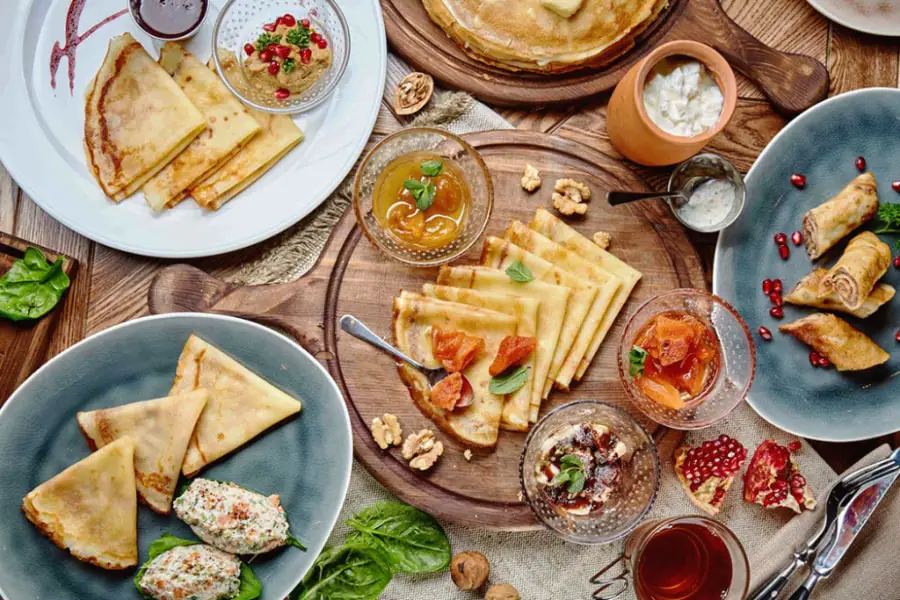
Where to try it: Specialising in blini, with over 30 sweet and savoury options on offer, Teremok is a wildly popular Russian food store chain. It may be fast food, but their delicate, flavoursome blini beat eating a happy meal any day of the week! With over 300 locations, practically every major city in Russia has a Teremok, so a blini fix is never far away.
Borscht
Although borscht (борщ) and its many variants are often considered iconic Russian food recipes, the beet-based soup is actually Ukrainian in origin and loved throughout the Slavic world. Bobbing around in the distinctly deep purple-red broth is a tasty treasure trove of mystery ingredients. Usually, you’ll find several types of meat, as well as sautéed vegetables like cabbage, carrots, onion, tomatoes, beetroot and potatoes. Borscht is served hot, usually with a dollop of sour cream on top. For the full-Russian experience it’s accompanied with a black Russian sourdugh bread Borodiksy, shaved frozen fat Salo, a clove of fresh garlic and a shot of ice-cold vodka.
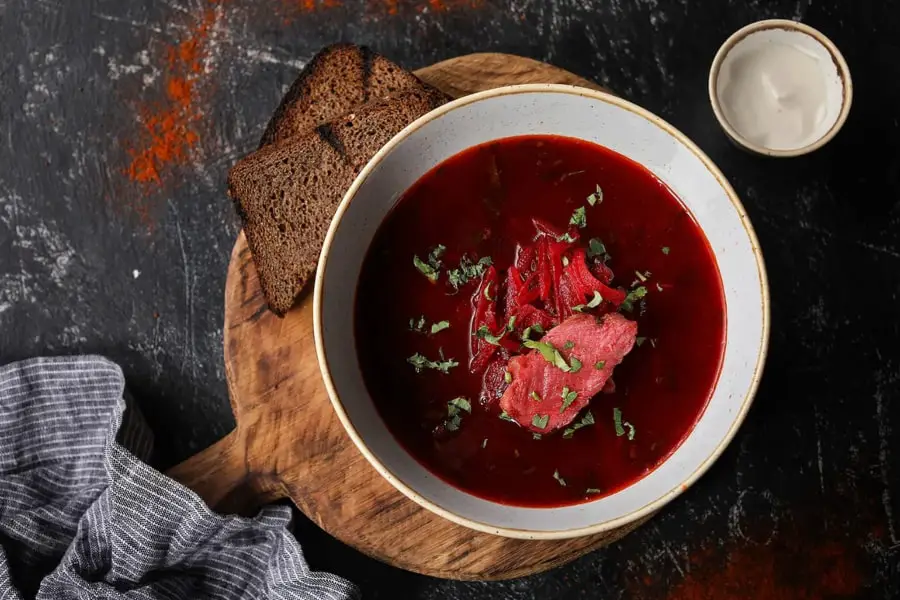
Where to try it: Borscht is found on the menus of high-class eateries and homely cafes alike. Grand Café Dr Zhivago, in the posh National Hotel Moscow, is famous for its decadent, Moscow-style borscht which features chunks of beef, ham and Vienna sausage.
Pelmeni
Pelmeni is the Russian version of boiled dumplings (it’s said the dish can be traced back to the influence of Chinese merchants who visited Siberia in the 15th century). These piping hot parcels of bite-sized goodness are made from unleavened dough, folded around a stuffing of ground meat (usually pork lamb, chicken or beef) and flavoured with onion, garlic, pepper and spices. An ideal cold climate food, the Siberians could freeze pelmeni outdoors in large batches, ensuring they had a well-preserved supply of meat to sustain them over winter.
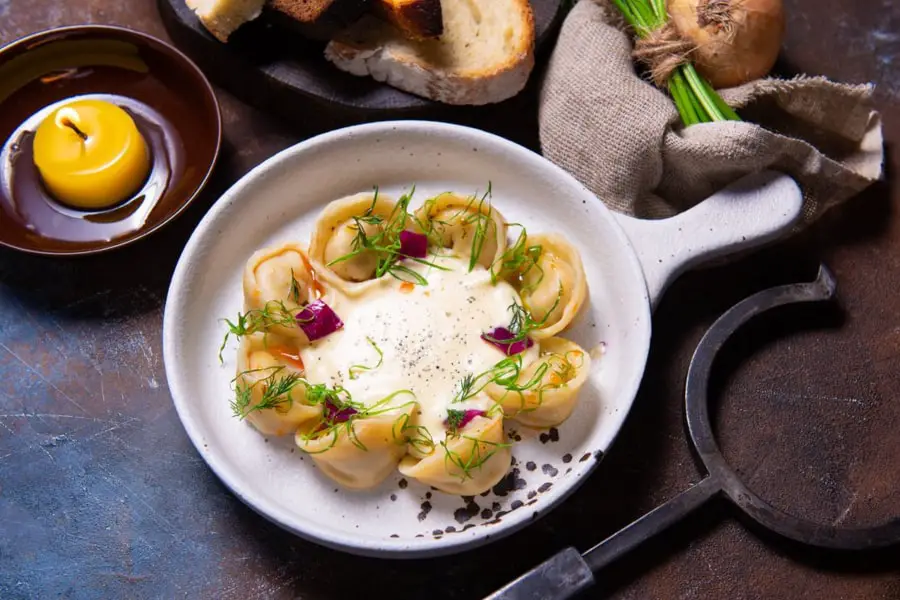
Where to try it: Pelmeni are beloved all over Russia, but to the best way to pay your respects to the pelmeni gods is to eat them in their homeland of Siberia. Real Zames in Irkutsk is a cozy restaurant that bakes up a mouth-watering daily selection, including Siberian-style Baikal fish pelmeni and fanciful fusions such as beef and cheese with pesto sauce.
Pirozhki
Literally “little pies”, pirozhki (or piroshki) are beautiful miniature stuffed buns of soft, buttery pastry encasing a savoury filling of meat and vegetables, often spiked with cheese and herbs for extra flavour. Pirozhki are a popular Russian Christmas food, often passed around the kitchen as a snack while aunties and grandmas are busy with the ritual of preparing an elaborate festive dinner. Baked, or sometimes fried, pirozhki also comes in sweet varieties with insides oozing with jam, stewed apples, cherries or cottage cheese.
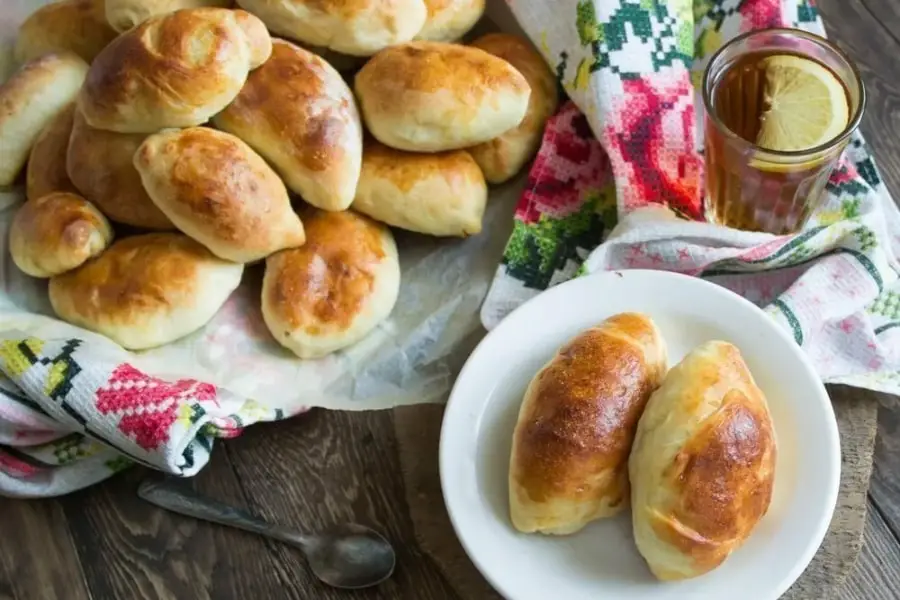
Where to try it: Easy to eat one-handed and on the go, pirozhki are perhaps the most commonly available street food in Russia. Vendors set up stalls in parks and on street corners hoping to tempt passers-by with an aroma of freshly baked pastry. In St Petersburg, head to old-school bakery Pirozhkovaya on Moskovsky Street for a taste of Soviet-era nostalgia that includes some of the city’s most popular pirozhki.
Beef Stroganoff
This famous Russian food is one of the best-known contributions to family dinner tables across western world – a classic comfort dish of sliced beef fillet, onion and mushrooms, sautéed in white wine and sour cream sauce. There are countless variations on the recipe, some calling for the addition of tomato paste, mustard or paprika. Legend has it the dish was named after the Stroganovs, a family of merchants who enjoyed immense wealth and power during the reign of the Tsars. What better way to leave your mark on history than lending your namesake to one of the most beloved icons in the traditional Russian cookbook?
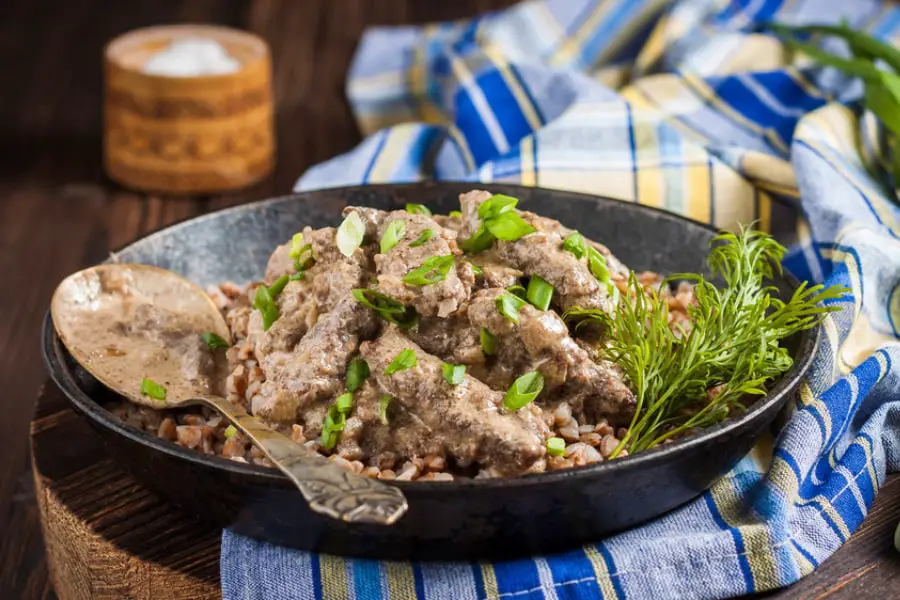
Where to try it: The beef stroganoff at Moscow’s Café Pushkin is legendary, served with roasted, chipped potatoes and an ultra-rich gravy sure to warm the heart and fill the belly.
Solyanka
Borscht may be better known, but solyanka is the real king of Russian soups – a thick, flavour-packed, meat-based broth that’s salty, spicy, sour and ever-slightly sweet. A winter favourite, Solyanka is prepared from choice cuts of meat, slow-cooked for several hours. A common recipe involves both cured and fresh beef as well as ham and sausages. Onions, carrots, garlic, peppers and tomato are added, with an array of other vegetables and herbs for extra colour. A dish that arrived in Russia by way of Georgia, it’s often eaten with adzhika (a spicy red sauce from the Caucus) and lavash (Georgian flatbread).
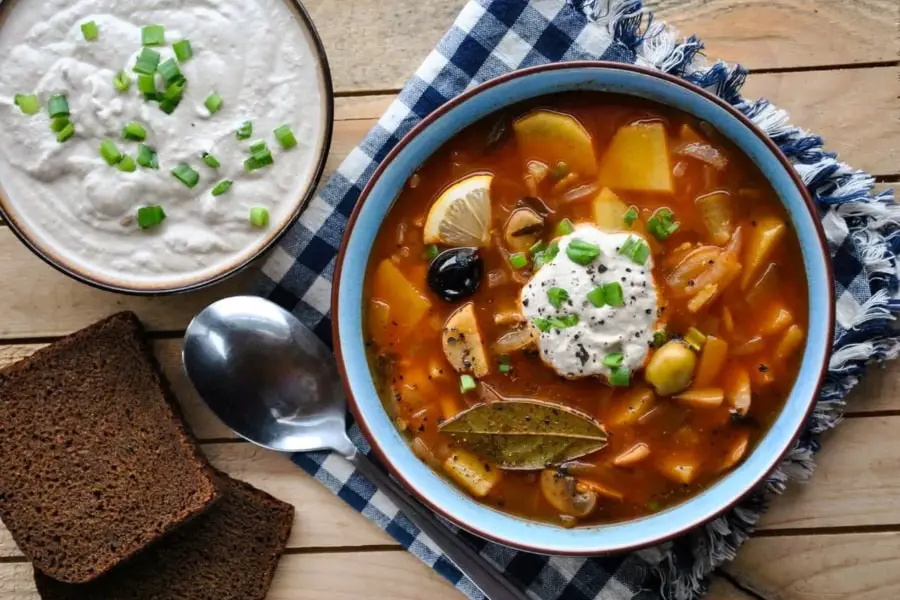
Where to try it: Each region of Russia has its own version of Solyanka, but the Tatar version is particularly unique. Kazan, the capital of Tatarstan is a fascinating stop on the Trans-Siberian railway. Here you’ll find many local eateries serving Solyanka ‘Kazan style’. The secret ingredient? Horse meat. So, if you’re not keen on eating Mr Ed, you might want to steer clear of Kazan’s take on this hearty Russian soup.
Olivier Salad
If you’ve spent a few days in Russia and starting to feel guilty about your fresh vegetable intake (let’s face it, the standard Russian diet isn’t the healthiest in the world), you might breathe a sigh of relief to spot Olivie (also called Olivier salad or sometimes simply ‘Russian salad’) on a restaurant menu. But prepared for a bit of a shock when the dish arrives as a multi-coloured mountain of diced potatoes, carrots, pickles, peas, eggs and several kinds of meat, all of it overdosing in an avalanche of mayo. A salad in the loosest definition of the world, Olivie is neither a healthy or sophisticated dish (despite being invented in Russia by a French-Belgian chef, Lucien Olivier), but it is delicious, in a potato salad on steroids sort of way!
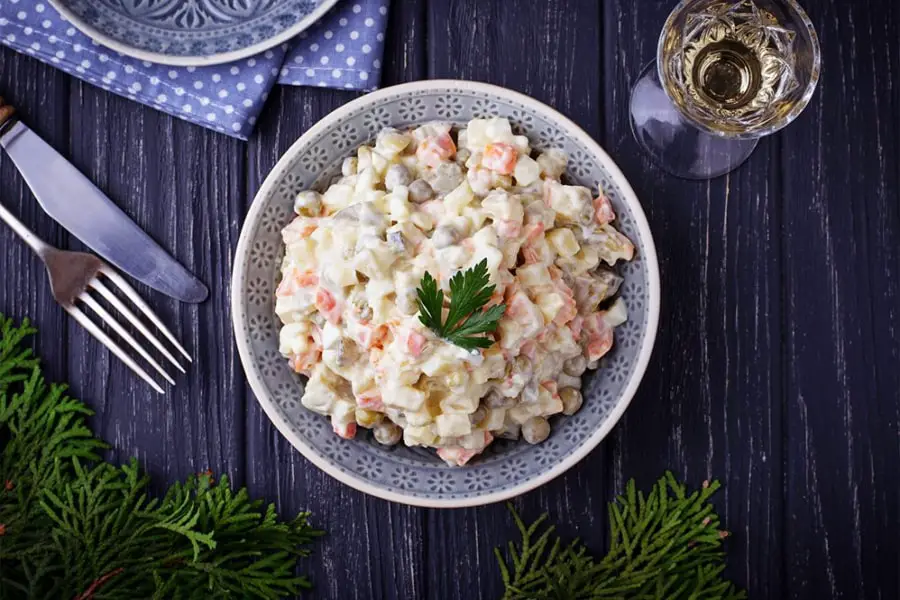
Where to try it: The Olivier salad was created in the 1860s in Moscow’s esteemed Hermitage restaurant. The establishment is no longer around today but its most famous invention is still served all over town. Restaurant Dacha Na Pokrovke’s rustic, country house atmosphere is a welcome respite Moscow’s busy city centre, serving classic dishes like Olivie in a peaceful, nostalgic setting.
Medovik
Russian food isn’t all just meat, meat, meat! Desserts have a special place in Russian food culture as well. One particularly decadent pastry found all over Russia is Medovik (honey cake). This soft, sticky, crumbly and creamy cake looks impressive and tastes divine, made up of multiple layers (supposedly 15 is the ideal number) of ginger and cinnamon-spiced honeyed pastry, with sweetened sour cream and condensed milk sandwiched in between. Sweet tooth? You want this.
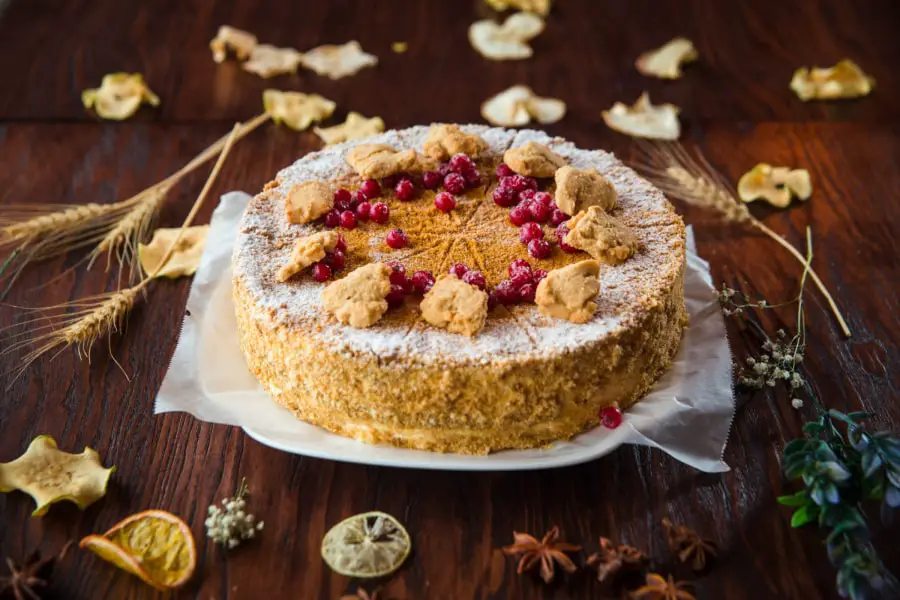
Where to try it: Medovik is a very traditional cake, so you’re the best bet for scoring a slice is finding an old-fashioned style bakery. In St Petersburg, Sova is a modestly priced café among the lovely old buildings on Mayakovskogo Street that does a good Medovik paired with tea or coffee.
Caviar
The luxury food most closely associated with the Russian aristocracy’s love of decadence, high-grade caviar (eekra) is the world’s most expensive food item, with the most exclusive varieties costing several thousand dollars for a single teaspoon’s worth. Despite its reputation as a delicacy, caviar is an acquired taste. The jelly-like,burst-in-your-mouth beads have an intense briny and fishy flavour. Caviar is the salt-cured eggs and roe traditionally extracted from wild (and now highly endangered) sturgeon. Cheaper varieties are derived from salmon, steelhead, trout, lumpfish and whitefish. In Russia, caviar is usually served with blini, chopped onion or pickles, quail eggs and sour cream which serve to tone down the extreme salt levels somewhat.
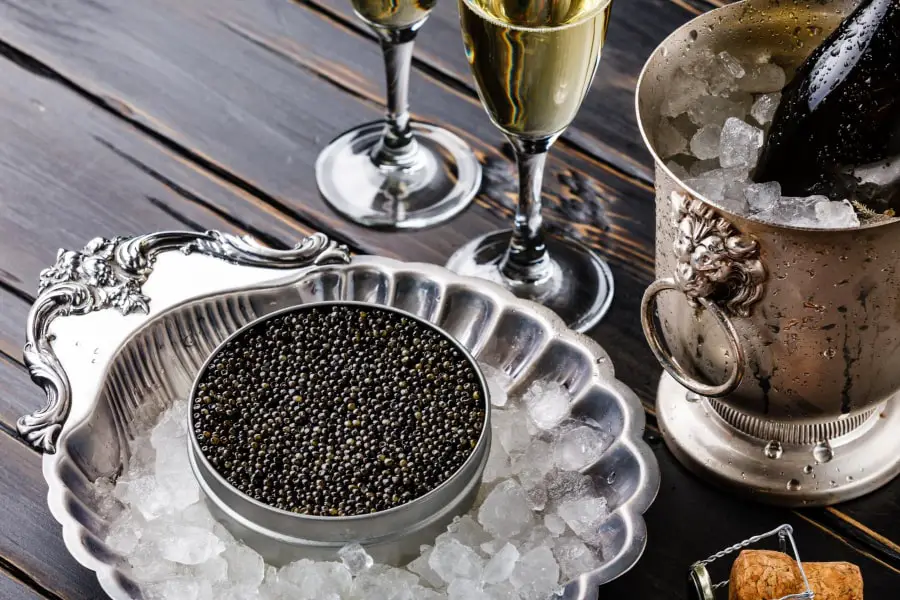
Where to try it: Given caviar’s association with extravagance, the best place to sample this exotic indulgence has to be amid the opulent surroundings of St Petersburg’s historic city centre. The glamorous Caviar Bar, in the Grand European Hotel, is devoted to pairings of fine beluga caviar with chilled vodka and fancy Russian snacks.
Kamchatka Crab
The red king crab or Kamchatka crab is one of the most highly sought-after seafood in the world, driving fearless fishermen to battle the freezing Arctic waters of the Bering Sea in the hopes of netting a haul of these overgrown crustaceans. Capable of growing to enormous sizes, red king crabs are native to the waters of Alaska and the Kamchatka Peninsula and are prized for their abundance of moist, sweet white flesh. Crabs from Kamchatka are exported around the world as a delicacy and attract a hefty price tag.
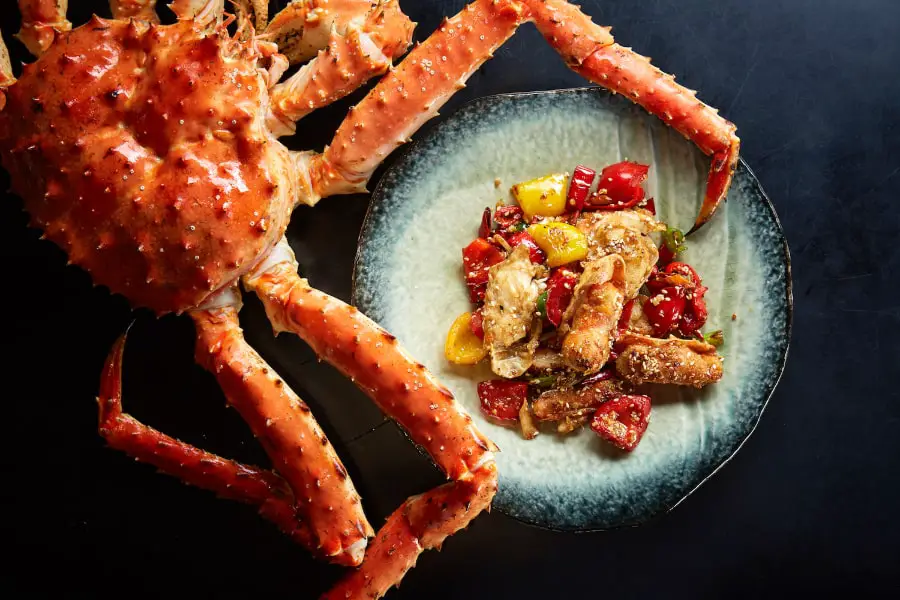
Where to try it: The famous Komsomol Square fish market in Kamchatka’s capital, Petropavlovsk-Kamchatsky on the Kamchatka Peninsula in Russian Far East, is one of the few places where you can try fresh king crab before it ends up frozen for export and sold for eye-watering prices in upscale restaurants. Amid the sights, sounds and bustling atmosphere of the market, live crabs can be chosen, bought and cooked on-site – a holy-grail experience for serious seafood lovers. In Moscow, we suggest visiting Crab and Wine or Erwin Reka.More.Okean restaurants, where you can find a wide variety of seafood including different types of crabs.
Moscow Mule
Moscow mules are refreshing on hot summer days, sure, but they’re also holiday-appropriate thanks to the strong ginger flavor. They strike that elusive balance between spicy, sweet and strong, and I’d sip one any day. Bonus: Moscow mules are super easy to make! You’ll need just three basic ingredients (ginger beer, vodka and lime). You’ll find exact measurements in the recipe provided below.
Moscow Mule Cocktail Recipe – Le Gourmet TV from heavyGFILMS on Vimeo.
Related posts
Related Tours
If you have any urgent questions or enquiries, please give us a call +61 412 587 785
